Caryn’s Thoughts

 My cousin, Darla Stanko passed away on February 26, 2023, at 63 just years old. As I think of Darla, I remember her laugh, which was just like her mother’s. It was sweet and a little shy, but when they laughed…you laughed, because their laugh was contagious. As kids, we would all go down in Grandma Byer’s basement to play, while the grownups visited upstairs. Grandma’s basement was a little creepy and worked well as a “haunted” house…if the kids liked that sort of thing. Some did and some didn’t. I preferred other games. I think Darla did too. She had asthma and scary stuff could trigger things.
My cousin, Darla Stanko passed away on February 26, 2023, at 63 just years old. As I think of Darla, I remember her laugh, which was just like her mother’s. It was sweet and a little shy, but when they laughed…you laughed, because their laugh was contagious. As kids, we would all go down in Grandma Byer’s basement to play, while the grownups visited upstairs. Grandma’s basement was a little creepy and worked well as a “haunted” house…if the kids liked that sort of thing. Some did and some didn’t. I preferred other games. I think Darla did too. She had asthma and scary stuff could trigger things.
As kids do, we all grew up…quicker than we would ever have dreamed possible. Before long, babies were coming along. I remember talking to Darla once. She told me that without a doubt, the best thing she ever did was JeanAnn, and of that I have no doubt. For a mom to look at the beautiful little baby they have just given birth to…there is no greater honor. Kids are a big part of our lives, and games are a part of kids. JeanAnn told me about the times she and her mom played cards. Their favorite game was Speed…which is a high drama card matching game for two players. It was perfect for them.
The other thing that JeanAnn and her mom loved to do was to spend time jumping on the trampoline in their yard. I can just picture it now, a summer evening in the back yard, just the two girls, jumping and giggling the hours away. Of course, there was also their dog, Nelly with them too. Now Nelly was a different sort of dog. She was very gentle with JeanAnn, but then she was JeanAnn’s guard dog. She was also gentle with Darla too…except for that one time. JeanAnn could make Nelly mad and then point at a new person, and Nelly would go get that person. That was all well and good…until JeanAnn did that to her mom. My guess is that JeanAnn had no idea what was about to take place. Darla saw it coming, and she jumped on the furniture to get away from the guard dog that was now hot on her trail. She almost knocked herself out jumping down. JeanAnn 
 says, “It was great” and maybe it was…for her anyway. Darla…maybe not so much, but I’m sure she laughed about it later.
says, “It was great” and maybe it was…for her anyway. Darla…maybe not so much, but I’m sure she laughed about it later.
Now, for me, possibly the funniest story about Darla’s life was the “fateful” trip to Denver. Darla decided to take her daughter to Denver, and to take her mom, my Aunt Delores Johnson with them. She needed a “navigator” and while I can’t picture my Aunt Dee in that capacity, maybe Darla thought map reading was like breathing…anyone could do it. My thought is, “Have you met your mother?” Anyway, off they went, and to make a long story short, they ended up on a one street in rush hour traffic, going the wrong way!!” Oh yes, that’s the Aunt Dee I know, and I can totally picture that whole situation…once I can stop laughing!!
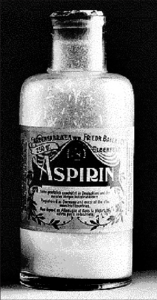
 Who hasn’t heard of Bayer Aspirin, or at the very least, aspirin? It has been a staple in households for as many as 124 years…until the Tylenol push, which in my opinion is the least effective pain medication of all time!!! Aspirin was developed from acetylsalicylic acid, which can be found in the bark of willow trees. Of course, it didn’t originate there. In its most primitive form, the active ingredient, Salicin was used for centuries in folk medicine, beginning in ancient Greece when Hippocrates used it to relieve pain and fever. I guess “modern medicine” hasn’t progressed so far after all. The Bayer version of aspirin was developed in Germany and patented on March 6, 1899. Even then, its unpleasant taste and tendency to damage the stomach, caused its sparing use. In the most modern adaptation of aspirin, the Bayer version, Bayer employee Felix Hoffmann found a way to create a stable form of the drug that was easier and more pleasant to take. Some evidence shows that Hoffmann’s work was really done by a Jewish chemist, Arthur Eichengrun, whose contributions were covered up during the Nazi era. After obtaining the patent rights, Bayer began distributing aspirin in powder form to physicians to give to their patients one gram at a time. The brand name came from “A” for acetyl, “spir” from the spirea plant, which was a source of salicin, and the suffix “in,” commonly used for medications. It quickly became the number-one drug worldwide.
Who hasn’t heard of Bayer Aspirin, or at the very least, aspirin? It has been a staple in households for as many as 124 years…until the Tylenol push, which in my opinion is the least effective pain medication of all time!!! Aspirin was developed from acetylsalicylic acid, which can be found in the bark of willow trees. Of course, it didn’t originate there. In its most primitive form, the active ingredient, Salicin was used for centuries in folk medicine, beginning in ancient Greece when Hippocrates used it to relieve pain and fever. I guess “modern medicine” hasn’t progressed so far after all. The Bayer version of aspirin was developed in Germany and patented on March 6, 1899. Even then, its unpleasant taste and tendency to damage the stomach, caused its sparing use. In the most modern adaptation of aspirin, the Bayer version, Bayer employee Felix Hoffmann found a way to create a stable form of the drug that was easier and more pleasant to take. Some evidence shows that Hoffmann’s work was really done by a Jewish chemist, Arthur Eichengrun, whose contributions were covered up during the Nazi era. After obtaining the patent rights, Bayer began distributing aspirin in powder form to physicians to give to their patients one gram at a time. The brand name came from “A” for acetyl, “spir” from the spirea plant, which was a source of salicin, and the suffix “in,” commonly used for medications. It quickly became the number-one drug worldwide.
In the beginning, like most drugs, Aspirin was a prescription-only drug, but in 1915, Aspirin was made available in tablet form and without a prescription. In 1917, when Bayer’s patent expired during the First World War, the Bayer company lost the trademark rights to aspirin in various countries. After the United States entered the war against Germany in April 1917, the Alien Property Custodian, a government agency that administers foreign property, seized Bayer’s US assets. Two years later, the Bayer company name and trademarks for the United States and Canada were auctioned off and purchased by Sterling Products Company, later Sterling Winthrop, for $5.3 million. 

As companies do, with mergers and splits, Bayer became part of IG Farben, the conglomerate of German chemical industries that formed the financial heart of the Nazi regime. Then after the Nazi defeat in World War II, the Allies split apart IG Farben, and Bayer again emerged as an individual company. With its purchase of Miles Laboratories in 1978, came a product line including Alka-Seltzer and Flintstones and One-A-Day Vitamins. Then in 1994, coming full circle, Bayer bought Sterling Winthrop’s over-the-counter business, which allowed it to gain back the rights to the Bayer name and logo, and after almost 100 years, and the company once again was allowed to profit from American sales of its most famous product.
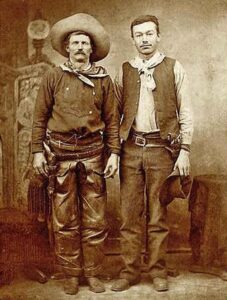
 When we think of a cowboy, we usually picture the American Cowboy, rough and rugged wearing a cowboy hat, a gun on his hip, and riding he favorite horse around the Old West. One thing we wouldn’t think of is that we really wouldn’t think of an American Cowboy being born in Canada. Nevertheless, one of the most “unusual” American Cowboys was actually born in Canada. His name was Charles Nebo, or as he was known by nickname, Charley, and he was born in March of 1842. Charles Nebo wasn’t your typical cowboy and might have even been more Forrest Gump than soldier, although he wasn’t autistic, like Forrest Gump was…or at least, not that anyone knew of.
When we think of a cowboy, we usually picture the American Cowboy, rough and rugged wearing a cowboy hat, a gun on his hip, and riding he favorite horse around the Old West. One thing we wouldn’t think of is that we really wouldn’t think of an American Cowboy being born in Canada. Nevertheless, one of the most “unusual” American Cowboys was actually born in Canada. His name was Charles Nebo, or as he was known by nickname, Charley, and he was born in March of 1842. Charles Nebo wasn’t your typical cowboy and might have even been more Forrest Gump than soldier, although he wasn’t autistic, like Forrest Gump was…or at least, not that anyone knew of.
Charlie never tried to inflate his achievements and was happy to live like a true frontier man, nevertheless, people often made him sound like he was…maybe, a little bit more of a cowboy than he actually was. I suppose it made no sense to say that he was just a “good old boy” from out west. People don’t expect that, and maybe, they just wouldn’t read about it, either, but the reality is that there were more average people in the American West than there were the wild people who made the West famous.
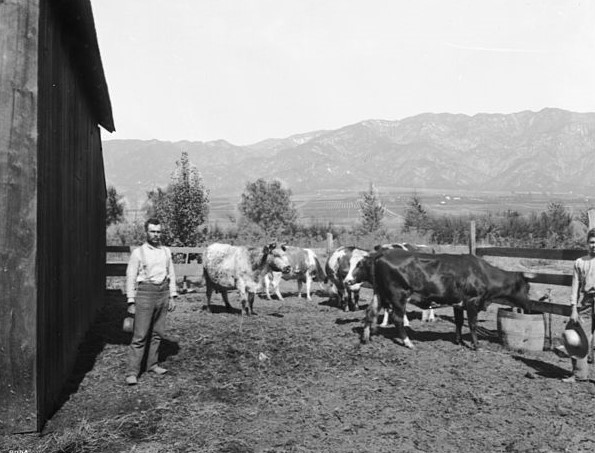
Charley Nebo lived in Canada until 1861. Then, he moved to Saginaw, Michigan. He was a Union soldier during the Civil War and went on to become a cowboy in New Mexico. At one point he actually befriended Billy the Kid. Nebo wrote about him in a letter, saying, “He wasn’t the ruthless bad fellow that Western history has made him out to be.” Nebo apparently gave people the benefit of the doubt, and himself, as a respected cowboy, once shot a man after witnessing him kill a Mexican boy’s dog. In all, Nebo was a common man, humble and capable. He wasn’t what people might call spectacular, but he was a good man, and it took a lot of those good men to build the American West.

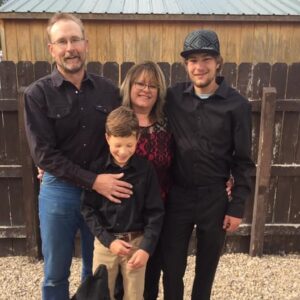 My sister-in-law, Rachel Schulenberg joined our family when she married my brother-in-law, Ron Schulenberg on June 2, 2010. It was a match made in Heaven. Rachel was introduced to Ron by his nieces, Machelle Moore and Susan Griffith. She was perfect for Ron. She was kindhearted and sweet, and a blessing to all who knew her. Rachel was a Christian girl, who worked at a church in Powell, Wyoming, when she was introduced to Ron. She was dedicated to the Lord, and witnessed to everyone she came across.
My sister-in-law, Rachel Schulenberg joined our family when she married my brother-in-law, Ron Schulenberg on June 2, 2010. It was a match made in Heaven. Rachel was introduced to Ron by his nieces, Machelle Moore and Susan Griffith. She was perfect for Ron. She was kindhearted and sweet, and a blessing to all who knew her. Rachel was a Christian girl, who worked at a church in Powell, Wyoming, when she was introduced to Ron. She was dedicated to the Lord, and witnessed to everyone she came across.
Rachel was a wonderful mom to her kids, Cassie Franklin, Riley Birky, and Tucker Schulenberg. She is also an amazing grandmother to her grandchildren, Lucas and Zoey Iverson. I just wish she had known her grandkids, Ryder Birky and Alicen Burr, as well as bonus baby, Jace. She would have absolutely loved these new little ones. Rachel really was a great mom and grandma. It really blessed her heart to become a grandma. I think that quite often, when we are done having kids, we almost immediately start to look forward to having grandkids. After all, it’s all about the babies. Who doesn’t love babies? No one, I know anyway!! 

Rachel was a part of our family for the last ten years of her life. Like her mother, Connie who died in 1985, when she was 35 years, Rachel passed away at a young age. Rachel was just 45 years old when she passed away. It is always so sad when someone so young leaves us so early. Rachel died of a stroke, which is, I believe, how her mother also passed away. Looking back, so many of us wish she was still with us today. Rachel had such a sweet way about her. Kindness radiated from her, because she was kind deep down in her heart. How can someone so young, leaves us so soon? When Rachel left us, she left a huge hole in the hearts of everyone who cared about her…and believe me, that was a lot of people.
Rachel changed everything in Ron’s life, and in the life of her kids and grandkids. My only wish is that their time w
 ith her hadn’t been so short. They all really needed her in their lives for many more years. Rachel’s influence in their lives was beyond huge. Everyone needs the influence of their mother and grandmother, but sadly, when they are gone, you really find out how badly you missed them. There are countless number of times that all you want to do is pick up that phone to ask them a question or tell them about your day. Today would have been Rachel’s 48th birthday. Happy birthday in Heaven, Rachel. We love and miss you very much, and can’t wait to see you in Heaven, when we all get there.
ith her hadn’t been so short. They all really needed her in their lives for many more years. Rachel’s influence in their lives was beyond huge. Everyone needs the influence of their mother and grandmother, but sadly, when they are gone, you really find out how badly you missed them. There are countless number of times that all you want to do is pick up that phone to ask them a question or tell them about your day. Today would have been Rachel’s 48th birthday. Happy birthday in Heaven, Rachel. We love and miss you very much, and can’t wait to see you in Heaven, when we all get there.

 My niece, Kaytlyn Griffith is in middle school now and she has done an amazing job with her grades. Her mom, Susan Griffith tells me that her grades are definitely better than Susan and Kaytlyn’s dad, Josh Griffith ever did. When the honor roll was released the last time a couple months ago Kaytlyn was on it with a 4.0 grade point average. Per parents were so proud, and she truly is an inspiration to them.
My niece, Kaytlyn Griffith is in middle school now and she has done an amazing job with her grades. Her mom, Susan Griffith tells me that her grades are definitely better than Susan and Kaytlyn’s dad, Josh Griffith ever did. When the honor roll was released the last time a couple months ago Kaytlyn was on it with a 4.0 grade point average. Per parents were so proud, and she truly is an inspiration to them.
Because they live in the country, and her parents work, Kaytlyn qualifies for a restricted driver’s license. Kaytlyn is so mature and smart, that even though she barely studied for the written test, she got a 100% on it!! She is very smart. Once a driver passes the written test, they have 30 days to take the driving test. Unfortunately, when Josh went to take Kaytlyn for the driving test, they were told that she had to have an appointment, which we didn’t know before, because it never was that way in years gone by. Anyway, they had to reschedule the test. They couldn’t get an appointment until the 30 day…talk about cutting it close. They were all quite stressed. If she didn’t pass, she wouldn’t be able to try again another year.
Then, they found out that the test in was in Cody, rather than Lovell because that was the only option. Well, that added another stress factor because the traffic in Cody is very different than the traffic in Lovell. So, they spent the Thanksgiving holiday break making trips to Cody, so she could practice there for 2 to 3 hours a day.
To make matters worse, it snowed quite a lot on the day of the test. Nevertheless, they had to go or Kaytlyn would have to wait for another year. Then, the lady asked if she wanted to reschedule, to which Kaytlyn answered, “Absolutely not!!” Kaytlyn took the test driving her mom’s Tahoe which had 4-wheel drive, thankfully with an inch of snow on the ground. Kaytlyn did amazing. She didn’t slide at all in the intersections…pretty good for a 14-year-old girl!! It helped that she got to drive slower because of the snow. In the end, the snow, which they thought was a negative factor, ended up helping her a lot. Kaytlyn passed!! Her parents were quote proud and relieved. She only did one thing wrong during the test. Not bad for a young, first-time driver.
Her parents were so proud of her, and her dad fixed up a little car for her. The front end had been wrecked, but 
 Josh had some new parts for it. Because it was two different colors, Josh, who is pretty innovative, made the color change a little more interesting by putting flames between the colors. It fits perfectly with Kaytlyn’s sense of humor.
Josh had some new parts for it. Because it was two different colors, Josh, who is pretty innovative, made the color change a little more interesting by putting flames between the colors. It fits perfectly with Kaytlyn’s sense of humor.
Kaytlyn has grown up so fast. As her mom was looking through pictures from the past couple years, she was shocked at how much she had blossomed into a beautiful young lady. With her grades and everything else in her life, Kaytlyn has a bright future ahead of her. With her grades and everything else, her parents are beyond proud of her. They love her so much that words don’t cany begin to explain it. And we are all very proud of her too. Today is Kaytlyn’s 15th birthday. Happy birthday Kaytlyn!! Have a great day!! We love you!!

 The Sinking Ship parking garage in Seattle is aptly named, a fact which you can clearly see when you look at it. The building is a multi-story parking garage in Pioneer Square and James Street to the north, Yesler Way to the south, and 2nd Avenue to the east. It is just steps away from the Pioneer Building on the site of the former Occidental Hotels and Seattle Hotel. The look of the structure gives the illusion of a sinking ship, even though it is level. After the Seattle Hotel was demolished in 1961, the Sinking Ship was built as part of a neighborhood redesign.
The Sinking Ship parking garage in Seattle is aptly named, a fact which you can clearly see when you look at it. The building is a multi-story parking garage in Pioneer Square and James Street to the north, Yesler Way to the south, and 2nd Avenue to the east. It is just steps away from the Pioneer Building on the site of the former Occidental Hotels and Seattle Hotel. The look of the structure gives the illusion of a sinking ship, even though it is level. After the Seattle Hotel was demolished in 1961, the Sinking Ship was built as part of a neighborhood redesign.
Designers Gilbert H Mandeville, an engineer and Gudmund B Berge, an architect of the Seattle firm Mandeville  and Berge built the structure in 1965. They also designed the Logan Building and an addition to the First Presbyterian Church downtown, the Ballard branch of Seattle Public Library, which is an unusual building too, although not like the Sinking Ship, and two buildings at the Seattle World’s Fair in 1962….the Alaska Building and the Transportation 21 Building, neither of which are really unusual.
and Berge built the structure in 1965. They also designed the Logan Building and an addition to the First Presbyterian Church downtown, the Ballard branch of Seattle Public Library, which is an unusual building too, although not like the Sinking Ship, and two buildings at the Seattle World’s Fair in 1962….the Alaska Building and the Transportation 21 Building, neither of which are really unusual.
The parking It is owned by the Kubota–Fujii family, who had acquired the Seattle Hotel in 1941. Doris Kubota, from the same family, called the garage the “ugliest building in all of Seattle.” During the 2001 Mardi Gras riot the building was used as a staging area for police and city officials. The Seattle Monorail Project had hoped to acquire the site through condemnation to turn it into a monorail station at the site of the Sinking Ship, but the Kubota family disputed the condemnation lawsuit, stating their intention to build housing and retail at the site.
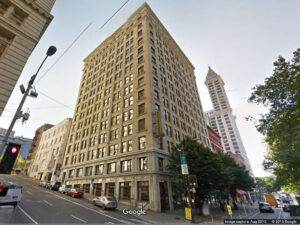
 While Doris Kubota thought the building was ugly, it was named the “coolest parking lot” in the United States by the design publication Architizer Journal in 2019 and still remains on that list today, dropping to 4th place. While I agree that it is cool, I’m not a fan of concrete buildings. Still, it makes sense for a parking structure to be made out of concrete. As of 2022, the garage is managed by Diamond Parking, and it is open 24 hours a day.
While Doris Kubota thought the building was ugly, it was named the “coolest parking lot” in the United States by the design publication Architizer Journal in 2019 and still remains on that list today, dropping to 4th place. While I agree that it is cool, I’m not a fan of concrete buildings. Still, it makes sense for a parking structure to be made out of concrete. As of 2022, the garage is managed by Diamond Parking, and it is open 24 hours a day.

 Yesterday, one of my granddaughter, Shai Royce’s co-workers, mentioned that her birthday was missing this year. I guess you could say that, but I told her that is just another Nano Birthday. Of course, that is when your birthday falls on that nano second between 11:59pm and 12:00am. That can only happen is you are a Leap Day Baby, which is exactly what Shai is. She didn’t know how she felt about that for a long time, mostly because her younger brother, Caalab told her that he was older that she is, which is technically true, because she only gets a “real” birthday every four years. She didn’t want him to be older than she was, because obviously, she was born first. She finally began to feel better about her birthday when I told her that the boys were older that she was, but they had to wait until they were 16 to get their driver’s license, but she could get hers when she was 4, and even then, she got to get it on the 28th rather than waiting until the 1st of March. So, it was earlier all the way
Yesterday, one of my granddaughter, Shai Royce’s co-workers, mentioned that her birthday was missing this year. I guess you could say that, but I told her that is just another Nano Birthday. Of course, that is when your birthday falls on that nano second between 11:59pm and 12:00am. That can only happen is you are a Leap Day Baby, which is exactly what Shai is. She didn’t know how she felt about that for a long time, mostly because her younger brother, Caalab told her that he was older that she is, which is technically true, because she only gets a “real” birthday every four years. She didn’t want him to be older than she was, because obviously, she was born first. She finally began to feel better about her birthday when I told her that the boys were older that she was, but they had to wait until they were 16 to get their driver’s license, but she could get hers when she was 4, and even then, she got to get it on the 28th rather than waiting until the 1st of March. So, it was earlier all the way 
 around. These days, like many Leap Day Babies, Shai has a two-day birthday, and sometimes she has a birthday week.
around. These days, like many Leap Day Babies, Shai has a two-day birthday, and sometimes she has a birthday week.
Shai is an insurance agent for Rice Insurance in Bellingham, Washington, and she is seriously the youngest insurance agent they have. While she is “technically” 27 years old today, in reality, she is 6¾ years old. I would say that is the youngest agent in Rice Insurance history…unless they have another Leap Day Baby in their midst. Either way, they take pretty good care of Shai, birthday or nano birthday. The have given her candles, which she loves, and one co-worker bought her pizza and a brownie for lunch today. Her parents threw her a party over the weekend, so it looks like she’s been pretty spoiled. I just wish we could have been there for it. Maybe next year.
Shai is a very social person and is well liked by everyone she knows. She makes friends easily, and often keeps 
 them for life. She has followed in the footsteps of her grandma and her mom, who are both insurance agents. In fact, I had the great privilege of training both of them to be insurance agents, and if I do say so myself, they are among the best in the business. I am so very proud of both of them. They even get to work together at Rice Insurance, although they often work from home these days, which is very cool too. Today is Shai’s 6¾s @ 27th birthday. Next year you can have a real birthday, Girlie. Happy birthday Shai!! Have a great day!! We love you!!
them for life. She has followed in the footsteps of her grandma and her mom, who are both insurance agents. In fact, I had the great privilege of training both of them to be insurance agents, and if I do say so myself, they are among the best in the business. I am so very proud of both of them. They even get to work together at Rice Insurance, although they often work from home these days, which is very cool too. Today is Shai’s 6¾s @ 27th birthday. Next year you can have a real birthday, Girlie. Happy birthday Shai!! Have a great day!! We love you!!

 With each passing year, I find myself feeling more and more blessed with this husband of mine. Bob and I met while I was working at Kmart, where his sister, Debbie Cook also worked, 49 years and 4 months ago. We have been married for 48 years as of today. There were people who didn’t think we has a chance for a lifelong marriage, but they were all wrong. I guess you could say that we are both stubborn…in a good way. We made a commitment, and we were determined to stay committed. The rest, as they say, is history. We have been blessed with two daughters, Corrie Petersen and Amy Royce; two sons-in-law, Kevin Petersen and Travis Royce; four grandchildren, Chris Petersen, Shai Royce, Caalab Royce, and Josh Petersen; a granddaughter-in-law, Karen Petersen and soon to be granddaughter-in-law, Athena Salazar; and three great grandchildren, Cambree, Caysen, and Justin Petersen. It doesn’t get much better than that.
With each passing year, I find myself feeling more and more blessed with this husband of mine. Bob and I met while I was working at Kmart, where his sister, Debbie Cook also worked, 49 years and 4 months ago. We have been married for 48 years as of today. There were people who didn’t think we has a chance for a lifelong marriage, but they were all wrong. I guess you could say that we are both stubborn…in a good way. We made a commitment, and we were determined to stay committed. The rest, as they say, is history. We have been blessed with two daughters, Corrie Petersen and Amy Royce; two sons-in-law, Kevin Petersen and Travis Royce; four grandchildren, Chris Petersen, Shai Royce, Caalab Royce, and Josh Petersen; a granddaughter-in-law, Karen Petersen and soon to be granddaughter-in-law, Athena Salazar; and three great grandchildren, Cambree, Caysen, and Justin Petersen. It doesn’t get much better than that.
Through the years, our lives have taken a number of turns. Things we expected and things we didn’t. We have made major job changes, to jobs we didn’t expect, Bob working for the City of Casper and me at The Stengel Agency, from which we would both retire. Of course, our family has grown and continues to grow. We began 

 our married life living in a mobile home, which we moved several times, and finally in 1995, we moved into town…the best move we ever made. I guess it took us that long to realize that we really didn’t like country life. We became caregivers in 2005, an eventually would take care of all four parents until each one passed away, the final one in 2018. That was probably the biggest, unexpected thing of all. When you are young, you naturally think your parents will live forever. We miss them very much and consider ourselves blessed to have had them with us for so long.
our married life living in a mobile home, which we moved several times, and finally in 1995, we moved into town…the best move we ever made. I guess it took us that long to realize that we really didn’t like country life. We became caregivers in 2005, an eventually would take care of all four parents until each one passed away, the final one in 2018. That was probably the biggest, unexpected thing of all. When you are young, you naturally think your parents will live forever. We miss them very much and consider ourselves blessed to have had them with us for so long.
The future is bright, and with retirement, we have more time to be together. I suppose some people think that all that time together would get…complicated, but for us it has not. We have always enjoyed our time together and have found that working different shifts at times was one of the hardest things we endured. I’ve heard people say that we should have fought less in those years, but we actually fought more, so there is another myth shot down. These days we like to travel, hike, spend time with our family. Of course, Bob still keeps busy 
 working on cars in our garage, and I have my writing. We find too, that we are homebodies to a degree, with Bob needing to be out and about more than I do. So, he runs to the parts house several times a day, hahahaha!! It’s his social life. I like to walk on the trail near our home, and the Carpet Trail (inside our house) in the winter. I always look forward to the warmer weather, because the Carpet Trail can get boring after a while. I would say that we have led a very blessed life!! Happy 48th anniversary, Bob!! I love you more each and every day!! Here’s to many more years of wedded bliss!!
working on cars in our garage, and I have my writing. We find too, that we are homebodies to a degree, with Bob needing to be out and about more than I do. So, he runs to the parts house several times a day, hahahaha!! It’s his social life. I like to walk on the trail near our home, and the Carpet Trail (inside our house) in the winter. I always look forward to the warmer weather, because the Carpet Trail can get boring after a while. I would say that we have led a very blessed life!! Happy 48th anniversary, Bob!! I love you more each and every day!! Here’s to many more years of wedded bliss!!

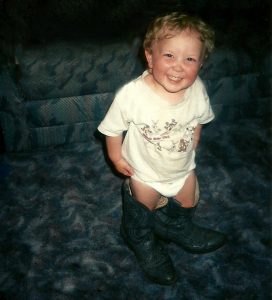 My grandson, Chris Petersen was the first one to make me a grandma. It was a wonderful day. Amazing, he managed to accomplish two great things that day making my goal of being a grandma by the time I was 40 and being born on his great grandmother, Joann Schulenberg’s birthday. I was privileged to be in the room when he arrived, and it was a wonderful blessing to me…one I will never forget. Chris was a wonderful and silly boy. He made the greatest faces and totally loved making all the animal sounds, and he knew them by heart.
My grandson, Chris Petersen was the first one to make me a grandma. It was a wonderful day. Amazing, he managed to accomplish two great things that day making my goal of being a grandma by the time I was 40 and being born on his great grandmother, Joann Schulenberg’s birthday. I was privileged to be in the room when he arrived, and it was a wonderful blessing to me…one I will never forget. Chris was a wonderful and silly boy. He made the greatest faces and totally loved making all the animal sounds, and he knew them by heart.
These days, Chris is all grown up, married to a wonderful girl named Karen, and has two wonderful babies of his own named Cambree and Caysen. He is the assistant 
 manager at Auto Zone in Casper, a job that is right up his alley. Chris is a car fanatic, and truly loves everything about his job. For a time, he was in food service, and while it was a job, it was not his heart. Since moving to Auto Zone, I have seen that happy boy come back. Chris is funny and loves to joke around. He is witty, and quick with a great punch line. He loves playing with his kids and making them laugh. When he is with them, he is a kid at heart. I love when he sends me funny texts or call to see if he can fool me, which he and Karen seem to be very good at. Hahaha!! It makes my day, when my kids and grandkids still want to talk or text me every day. It warms my heart to see Chris so happy with his life. He is very blessed.
manager at Auto Zone in Casper, a job that is right up his alley. Chris is a car fanatic, and truly loves everything about his job. For a time, he was in food service, and while it was a job, it was not his heart. Since moving to Auto Zone, I have seen that happy boy come back. Chris is funny and loves to joke around. He is witty, and quick with a great punch line. He loves playing with his kids and making them laugh. When he is with them, he is a kid at heart. I love when he sends me funny texts or call to see if he can fool me, which he and Karen seem to be very good at. Hahaha!! It makes my day, when my kids and grandkids still want to talk or text me every day. It warms my heart to see Chris so happy with his life. He is very blessed.
Chris has a Camaro, and he has decided that he is going to wrap it with Rhino, which I think looks very cool. He 
 hasn’t said if he will go black or choose a color, but I’ve seen some of these done, and it is cool. His car has won him awards, and he is very proud of it. His kids love to be in the car too, so I guess they know a hot rod when they see one. They are their daddy’s kids after all. Of course, the Camaro is a summer car. Chris and Karen have 4-wheel drives for the winter weather, and this year it has been a good thing. We have had a banner snow year in Casper, and 4-wheel drive is essential. Nevertheless, Summer is coming, and it will be nice to take out the old hot rod sometimes. Today is Chris’ 27th birthday…how can that be already?? Happy birthday Chris!! Have a great day!! We love you!!
hasn’t said if he will go black or choose a color, but I’ve seen some of these done, and it is cool. His car has won him awards, and he is very proud of it. His kids love to be in the car too, so I guess they know a hot rod when they see one. They are their daddy’s kids after all. Of course, the Camaro is a summer car. Chris and Karen have 4-wheel drives for the winter weather, and this year it has been a good thing. We have had a banner snow year in Casper, and 4-wheel drive is essential. Nevertheless, Summer is coming, and it will be nice to take out the old hot rod sometimes. Today is Chris’ 27th birthday…how can that be already?? Happy birthday Chris!! Have a great day!! We love you!!
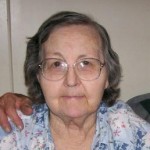
 My mother-in-law, Joann Schulenberg was stay-at-home mom for most of her life. She cooked and baked, as well as sewing, knitting, and crocheting, in addition to the normal stay-at-home mom duties. She was an excellent cook, and the thought of her baking prowess still makes my mouth water. I came across some Cinnabon sticky buns at Walmart the other day, and it reminded me of her Carmel Pecan Cinnamon Rolls. Nobody…and I mean nobody, made Carmel Pecan Cinnamon Rolls like she did. They were amazing!! She also made Murder Cake, which was like a chocolate cake with pudding dumped on it. It was so rich and yummy!! She also canned vegetables and meats for many years. Raising a cow at their property in the country made that feasible.
My mother-in-law, Joann Schulenberg was stay-at-home mom for most of her life. She cooked and baked, as well as sewing, knitting, and crocheting, in addition to the normal stay-at-home mom duties. She was an excellent cook, and the thought of her baking prowess still makes my mouth water. I came across some Cinnabon sticky buns at Walmart the other day, and it reminded me of her Carmel Pecan Cinnamon Rolls. Nobody…and I mean nobody, made Carmel Pecan Cinnamon Rolls like she did. They were amazing!! She also made Murder Cake, which was like a chocolate cake with pudding dumped on it. It was so rich and yummy!! She also canned vegetables and meats for many years. Raising a cow at their property in the country made that feasible.
She spent her life perfecting her knitting, sewing, and crocheting, and she could make just about anything. Many people have been the beneficiaries of her work, and she made money on her things too. Craft fairs were her main selling place, but once her name was known, she got lots of calls for her crafts too. She could knit and crochet in her sleep and never miss a stitch. When she was diagnosed with Alzheimer’s Disease, and later when she moved into a nursing home, her knitting and crocheting went with her…in her mind anyway. She would see her oxygen tubing or a string on a blanked of piece of clothing and she would pick it up and “pick up” where she left off.
She was always cooking when she was at home, and so when they would tell her it was time for dinner at the nursing home, she would often tell them that she would get the potatoes on. All of the CNAs got a kick out of that, and then, they would tell her that it wasn’t her night to cook. That always put a smile on her face. If someone else did the cooking, that meant she could relax, for once. Never one to complain, she was a favorite out there. She was a people watcher, so being at the nursing home was entertainment for her too. She couldn’t 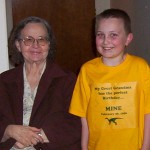
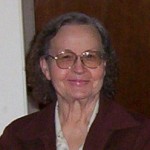 quite figure out the relationships there, and often thought that the CNAs were spouses to the residents. Then, when they would go help a different resident, she would ask me why that “girl” was sitting with that man, when her husband was this other man. It was really quite comical. I never thought of Alzheimer’s Disease as a curse, like many people do. My mother-in-law didn’t grieve, because she didn’t realize they were gone. They would always be back soon. Today would have been my mother-in-law’s 92nd birthday. Happy birthday in Heaven, Mom. We love and miss you very much.
quite figure out the relationships there, and often thought that the CNAs were spouses to the residents. Then, when they would go help a different resident, she would ask me why that “girl” was sitting with that man, when her husband was this other man. It was really quite comical. I never thought of Alzheimer’s Disease as a curse, like many people do. My mother-in-law didn’t grieve, because she didn’t realize they were gone. They would always be back soon. Today would have been my mother-in-law’s 92nd birthday. Happy birthday in Heaven, Mom. We love and miss you very much.

